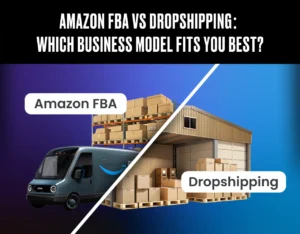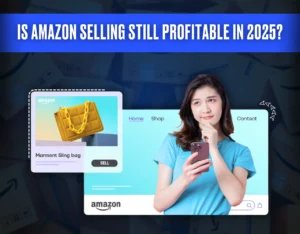If you are a seller on Amazon, you might have heard the terms 1P and 3P.
In the 1P (First-Party) model, you act as a wholesaler. Amazon buys your products in bulk, manages pricing, listings, and even handles customer service.
In contrast, 3P (Third-Party) sellers have full control over their accounts. You use Seller Central to list and sell directly to customers, either fulfilling orders yourself or through Fulfillment by Amazon (FBA).
Both methods have their own plus points, but they operate differently. Continue reading to learn about both models in detail with the help of 7 key differences. Let’s head on to the details!
Amazon 1P vs 3P: Which Factors Set Them Apart
Let’s dig into a side-by-side comparison of 1P and 3P in real-world scenarios and see which one ticks the boxes for you.
| Factor | Amazon 1P (First-Party) | Amazon 3P (Third-Party) |
| Sales Platform | Operates through Vendor Central, which is invite-only and designed for wholesalers. | Operates via Seller Central, open to all, suited for individual or business sellers. |
| Customer Access | Amazon handles all customer interactions and support. | You manage customer service, communication, and relationships directly. |
| Listing Control | Limited control as Amazon creates and manages listings. | Full control as you create, optimize, and update listings as needed. |
| Buy Box Role | Typically prioritized for the Buy Box due to Amazon’s own platform preference. | Must win the Buy Box through competitive pricing and seller metrics. |
| Product Visibility | Often receives better visibility in search and advertising placements. | Visibility depends on listing quality, pricing, and performance metrics. |
| Returns & Customer Service | Amazon handles returns and support. | You handle it yourself or use FBA to delegate to Amazon. |
| Brand Voice | Amazon controls how your product and brand appear. | You maintain full brand control, including imagery and messaging. |
| Pricing Control | Amazon sets final prices and may apply discounts or promotions. | You control product pricing, discounting, and deal strategy. |
| Inventory Management | You ship bulk inventory to Amazon; they control reordering and storage. | You manage inventory levels and fulfillment speed through FBA or self-fulfillment. |
| Payment Terms | Payment cycles can extend 30–90 days. | More frequent payouts, often every 14 days. |
| Marketing Flexibility | Limited options, mostly managed by Amazon. | You can run ads, coupons, and deals without needing Amazon’s approval. |
Pros and Cons of Amazon 1P vs 3P
If you value ease and scalability, 1P is appealing because Amazon handles everything. But if brand control and higher profit margins matter more to you, 3P is worth exploring.
Here’s a simple breakdown of the positives and shortcomings in both models to help you understand which one aligns best with your goals:
Benefits of Amazon 1P
Allow us to present to you the perks of Amazon 1P:
- Recognized by Customers: Amazon labels these listings as “Sold by Amazon,” which builds instant trust among buyers. This tag often increases click-through rates and conversion, especially for first-time shoppers.
- Operational Saving: You don’t have to worry about pricing, shipments, returns, or customer support. Amazon handles everything on your behalf.
- Visibility Advantages: Amazon tends to push 1P products in advertising slots and organic search, leading to higher sales volume for listed items.
- Marketing Tools Access: You automatically get access to premium features like A+ Content without going through brand registry processes.
Drawbacks of Amazon 1P
Find the cons of Amazon 1P below:
- No Pricing Control: Amazon sets your product price, and they may apply discounts or bundles without your consent.
- Long Payment Cycles: Payments are often delayed 30, 60, or even 90 days after the sale, which can affect cash flow.
- Reduced Margins: Additional fees like freight, chargebacks, and co-op advertising can eat into your profits.
Pros of Amazon 3P
Attached below are the pros of Amazon 3P:
- Full Control Over Pricing: You set the price of your products and can adjust them anytime based on market trends or stock levels.
- Stronger Brand Presence: You control your listings, titles, descriptions, and images, which helps build a unique brand identity on Amazon.
- Higher Profit Margins: Without selling at wholesale rates to Amazon, you keep more of the revenue from each sale, especially on niche or premium items.
- Flexible Promotions: You can launch coupons, run limited-time deals, and create custom ads without needing Amazon’s approval.
Cons of Amazon 3P
The following are the disadvantages of Amazon 3P:
- More Workload: You’re responsible for customer service, order fulfillment, inventory, and pricing unless you use FBA.
- Tough to Learn: Seller Central isn’t always intuitive, especially for new sellers with limited e-commerce experience.
- Competition and Scams: You’ll face intense competition and the occasional threat of listing hijackers or counterfeiters.
Can I Be Both a 1P and 3P Seller?
Yes, you can set foot in the two boats at the same time. Many brands do it. It’s called a hybrid model.
In this approach, you sell core products via 1P for bulk exposure and stability, while testing new products or higher-margin items as a 3P seller. It gives you the best of both worlds, reach and control.
Benefits of the Hybrid Model
The hybrid model gives you the ability to pivot quickly, balance risk, and improve your Amazon presence. Here are some benefits:
- Flexibility: Use 1P or 3P depending on seasonal demand, product type, or pricing goals.
- Risk Buffer: If issues arise in one model, such as pricing conflicts or delayed purchase orders, you have the other as a backup.
- Wider Market Access: Sell in both wholesale and direct-to-consumer channels to tap broader customer segments.
- Inventory Flow: Offload surplus or low-velocity stock through your 3P account without relying on Amazon’s buying schedule.
- Negotiation Strength: Operating successfully as a 3P seller gives you more leverage when discussing terms or disputes with Amazon as a 1P vendor.
How to Become a 1P or 3P Seller on Amazon?
Getting started depends on the model you choose. 1P is invitation-only and ideal for established brands with bulk supply capabilities. 3P is open to everyone and offers full seller control from day one. Here’s what you need to know:
How to Be a 1P Seller?
You can’t directly apply for Amazon’s 1P program (Vendor Central). Amazon extends invitations to brands that show strong performance as 3P sellers or have established market demand.
Once invited, you’ll receive purchase orders and ship products to Amazon, which then sells to customers under its name. You can find items sold and shipped by Amazon to understand how the platform handles 1P accounts and learn about their process in detail.
How to Be a 3P Seller?
Anyone can sign up through Amazon Seller Central. After registration and approval, you can list your products, choose between Fulfilled by Amazon (FBA) or Fulfilled by Merchant (FBM), and begin selling directly to customers.
How to Transition from 1P to 3P on Amazon
Many brands move from 1P to 3P to gain control over pricing, branding, and fulfillment. As you begin to adapt to the new model, these are the core aspects you will have to focus on:
- Product Listings: Creating, maintaining, and optimizing the listings will be entirely up to you.
- Inventory Syncing: Maintain consistent stock levels to avoid overselling or stockouts.
- Order Management: Choose between FBA (Amazon handles delivery) or FBM (you fulfill orders).
- Pricing Strategy: Make as many adjustments to pricing as necessary since you will no longer be interfered with.
- Brand Voice: Manage how your products are portrayed and oversee brand representation.
During the switch, it’s crucial to monitor Buy Box competition, sync inventory properly, and manage customer support actively. Tools like automated repricers and inventory management platforms can ease this shift.
This Reddit thread shares how brands mix both models to gain pricing control, handle new product launches, and keep inventory flowing smoothly.
How Do You Use Your 1P & 3P Accounts?
byu/ishudbworking inVendorCentral
Amazon Third-Party Seller Scams
The 3P world opens doors for new opportunities, but they are also accompanied by risks. Listed below are some common scams to watch out for:
- Fake Sellers: Unauthorized merchants may list counterfeit versions of your product, undercutting price and damaging brand trust. Customers often cannot tell the difference until it’s too late.
- Account Hijacking: Dormant or poorly secured accounts are common targets. Once compromised, hackers may redirect payouts or list fake products.
- Listing Manipulation: Competitors may alter your listings or report false intellectual property violations to suppress your visibility and sales.
- Fake Reviews: Purchased positive or negative reviews can skew buyer perception. Inaccurate ratings mislead shoppers and erode brand credibility.
We’d recommend you always enable two-factor authentication, monitor your listings, and work with Amazon-approved service providers. These actions will ensure your business runs smoothly without any hassle.
How Impact Wolves Optimizes Your Amazon Store for 1P and 3P Sales?
Impact Wolves helps 1P and 3P Amazon sellers fix underperforming campaigns, improve listing visibility, and scale profitably with customized PPC strategies.
We can help you with full-funnel ad management or help reduce ACOS. On top of that, our team also handles everything from Sponsored Products to Brand and Video ads, with a 30-day money-back guarantee. Talk with our PPC ads expert for free and start your Amazon PPC campaign now.
Moving from 1P to 3P
byu/maxwellcawfeehaus inVendorCentral
FAQs
What is a 1P transaction on Amazon?
1P transaction means Amazon buys a product directly from a vendor and resells it to the customer.
What is a 3P 1P strategy?
3P 1P strategy is a hybrid approach where you use both models 1P for reach and 3P for control. The goal is that you can balance exposure, pricing flexibility, and profit potential.
Which is better between 1P and 3P?
1P is a better option if you want a smooth process with quick access to a large customer base and potential for high sales volume. However, 3P gives better control of pricing, giving a better potential for higher profit with more scalability.
Conclusion
The final say between Amazon 1P vs 3P comes down to your business goals. If you prefer a more relaxed, hands-off style and are comfortable relinquishing some control, then 1P may work well for you.
But if you are concerned about establishing a brand that lasts for the long term, controlling pricing, and retaining ownership of the customer experience, then 3P might be the preferred option.
Whichever model you opt for, being aware of the differences upfront can end up saving you money, time, and headaches later on.






One Response
This comparison between 1P and 3P selling models is clear and practical. Highlighting the trade-off between control and simplicity really helps brands evaluate which approach aligns with their e-commerce goals.